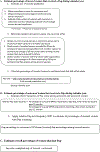Use of claims data to estimate annual cervical cancer screening percentages in Portland metropolitan area, Oregon
- PMID: 26897463
- PMCID: PMC11934870
- DOI: 10.1016/j.canep.2016.01.010
Use of claims data to estimate annual cervical cancer screening percentages in Portland metropolitan area, Oregon
Abstract
Background: Human papillomavirus (HPV) vaccine should reduce cervical dysplasia before cervical cancer. However, dysplasia diagnosis is screening-dependent. Accurate screening estimates are needed.
Purpose: To estimate the percentage of women in a geographic population that has had cervical cancer screening.
Methods: We analyzed claims data for (Papanicolau) Pap tests from 2008-2012 to estimate the percentage of insured women aged 18-39 years screened. We estimated screening in uninsured women by dividing the percentage of insured Behavioral Risk Factor Surveillance Survey respondents reporting previous-year testing by the percentage of uninsured respondents reporting previous-year testing, and multiplying this ratio by claims-based estimates of insured women with previous-year screening. We calculated a simple weighted average of the two estimates to estimate overall screening percentage. We estimated credible intervals using Monte-Carlo simulations.
Results: During 2008-2012, an annual average of 29.6% of women aged 18-39 years were screened. Screening increased from 2008 to 2009 in all age groups. During 2009-2012, the screening percentages decreased for all groups, but declined most in women aged 18-20 years, from 21.5% to 5.4%. Within age groups, compared to 2009, credible intervals did not overlap during 2011 (except age group 21-29 years) and 2012, and credible intervals in the 18-20 year group did not overlap with older groups in any year.
Conclusions: This introduces a novel method to estimate population-level cervical cancer screening. Overall, percentage of women screened in Portland, Oregon fell following changes in screening recommendations released in 2009 and later modified in 2012.
Keywords: Cervical cancer screening; Cervical dysplasia; Cervical intraepithelial neoplasia (CIN); HPV vaccines; Human papillomavirus (HPV).
Copyright © 2016 Elsevier Ltd. All rights reserved.
Conflict of interest statement
Conflict of interest
All authors declare no conflicts of interest, financial or otherwise.
Figures
References
-
- Bosch FX, Burchell AN, Schiffman M, Giuliano AR, de Sanjose S, Bruni L, et al., Epidemiology and natural history of human papillomavirus infections and type-specific implications in cervical neoplasia, Vaccine 26 (August (19) Suppl. (10)) (2008) K1–K16. - PubMed
-
- Saslow D, Runowicz CD, Solomon D, Moscicki AB, Smith RA, Eyre HJ, et al., American Cancer Society guideline for the early detection of cervical neoplasia and cancer, CA: Cancer J. Clin 52 (November–December (6)) (2002) 342–362. - PubMed
-
- Hariri S, Unger ER, Powell SE, Bauer HM, Bennett NM, Bloch KC, et al., The HPV vaccine impact monitoring project (HPV-IMPACT): assessing early evidence of vaccination impact on HPV-associated cervical cancer precursor lesions, Cancer Causes Control: CCC 23 (February (2)) (2012) 281–288. - PubMed
-
- Cuzick J, Myers O, Hunt WC, Robertson M, Joste NE, Castle PE, et al., A population-based evaluation of cervical screening in the United States: 2008–2011. Cancer epidemiology, biomarkers & prevention: a publication of the American Association for Cancer Research, cosponsored by the American Society of Preventive Oncology 23 May (5) (2014) 765–773. - PMC - PubMed
-
- Breen N, Wagener DK, Brown ML, Davis WW, Ballard-Barbash R, Progress in cancer screening over a decade: results of cancer screening from the 1987, 1992, and 1998 National Health Interview Surveys, J. Natl. Cancer Inst 93 (22) November (21) (2001) 1704–1713. - PubMed
Publication types
MeSH terms
Substances
Grants and funding
LinkOut - more resources
Full Text Sources
Other Literature Sources
Medical
Research Materials



